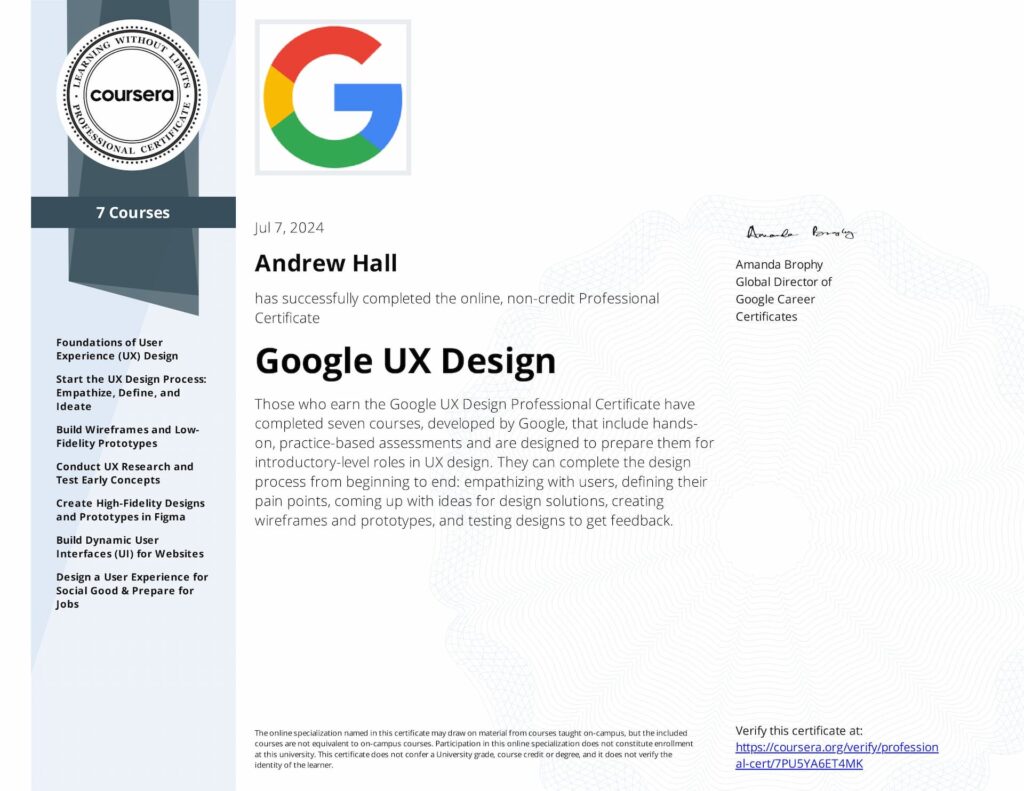Case Study for Google UX Design Professional Certificate
To expand on my knowledge that I had already gained from the UXDI Diploma, I enrolled in the Google UX Design Professional Certificate. This would cement my knowledge and also gain accreditation from a world-renown name.
In addition, this would also increase my knowledge in creating designs for a wide range of audiences, with a focus for accessibility, such as designing for users with low vision or mobility impediments.
Course 1 - Start the UX Design Process: Empathize, Define, and Ideate
The first course is designed to understand empathising with users, and ideate for for solutions. This is a key starting point, as helps view a problem for the users point of view, such as issues with existing solutions, and how to design solutions for a wide range of users.
This course also covered other areas such as how solutions can be ideated, the wide range of responsibilities UX designers have, and the different methods of obtaining data to back up possible solutions.
A key difference I noticed compared to the UXDI course, is that Google’s course has a much greater focus on accessibility and inclusivity, which would help me increase my knowledge in creating designs that are WCAG compliant.
Course 2 - Conduct UX Research and Test Early Concepts
This course focused on planning and conducting usability studies, and using observations from those studies to come up with insights. As I have already learnt in the UXDI course, research is a key part of UX design, and this course helped me gain a greater understanding of how to turn insights from research into solutions.
Additionally, I have learnt how to present insights to audiences such as developers and shareholders.
Course 3 - Build Wireframes and Low-Fidelity Prototypes
This course was aimed at creating a storyboard, and then turning paper prototypes into interactive designs, and then creating a low-fidelity prototype in Figma.
Storyboarding is a useful step as it helps define a goal statements, and give a better understanding of what is required. I also created a paper prototype, and a low-fidelity design in Figma.
Lastly, I learnt about implicit bias and deceptive designs patterns.
Course 4 - Build Dynamic User Interfaces (UI) for Websites
This course increased my knowledge of planning the information architecture and sitemaps for websites, and applying the UX design-thinking framework to create a website.
This course helped define the different types of website, and how to choose which type to design for for a new website project. Additionally, this course also included informations and details on how to design websites for accessibility.
Course 5 - Foundations of User Experience (UX) Design
This project required me to review the interview I recorded in Project 4 into an Affinity Diagram, by making notes, and organise them into categories on a whiteboard.
An affinity diagram is a useful way of organising data into logical categories, and can be used to make evidence-based decisions.
Course 6 - Design a User Experience for Social Good & Prepare for Jobs
This project required me to create a Customer Journey Map, which documents the users Goals, Behaviours and feelings during a process such as booking a hotel room.
Creating a customer journey map can be useful as it can help define the users temperament during the process, and identify points that could be improved.
I created this customer journey map in Miro.
Course 7 - Create High-Fidelity Designs and Prototypes in Figma
This project required me to create a user flow diagram for my website design, which would define the full process of booking a hotel room, from the homepage to the payment screen, and also identify the interaction points in between each step of the process.
Firstly I drew my flow diagram by hand, and then I recreated it in digital format in Draw.io.
Certificate
Finally, I needed to pass an exam covering all aspects of the course, from research to prototyping. I passed with flying colours, and received my certificate demonstrating that I am now a certified UX professional.
“Recipients of this university-accredited qualification in UX Design have demonstrated the ability to bring a user-centred mindset to product design projects. Recipients of this diploma can prepare and conduct a variety of user research studies to develop a broad and deep understanding of user goals and problems. Recipients can use a number of analysis frameworks to clearly articulate the existing customer experience. Recipients can design common desktop and mobile workflows such as registration, onboarding and payment. Recipients can design and build high-fidelity prototypes using popular prototyping tools and annotate wireframe specifications for developer handover.”
